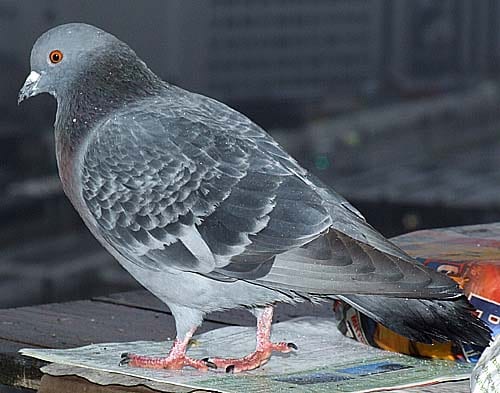
by Pigeon Patrol | Aug 26, 2021 | Bird Netting, Bird Spikes, Columbidae, Doves, history of pigeons, MBCA, pet bird
Is your car frequently covered in bird poop? Part of it could be the color your car. A study has revealed red cars attract more bird droppings than any other color. The research, conducted by U.K. car parts retailer Halfords, revealed red vehicles made up 18% of cars marked by birds, while blue followed along in second place at 14%. Green vehicles got off the easiest, making up just 1% of those in the study. The sample included 1,140 cars, though there’s no indication as to the total number of each car color in the group.
During the study, drivers were also asked how quickly they removed droppings from their cars. Only 17% – one in six – said they wiped off deposits immediately when they saw them, 20% said they took action “within a couple of days” while 55% waited until the next car wash. The remaining 8% never washed their cars – or left it to others to clean it off for them.
As well as being unsightly, insurance industry figures show bird droppings on vehicles can be an expensive problem and estimate the damage caused by bird-poop-stained paintwork costs motorists millions per year in unnecessary repairs.
Halfords car cleaning expert David Howells said: “This research does have a serious side because the problem annoys drivers, causes damaged paintwork and affects the value of vehicles. To protect your bodywork from damage, droppings should be carefully cleaned off as soon as possible.”
Theories abound on motoring and social networking websites as to why birds are attracted to pooping on some cars more than others. A Lexus driver reckoned newly polished cars suffer because birds see a reflection of themselves. A Ford Focus owner agreed and said the darker the color the deeper the reflection and the more violent the reaction. An Alfa Romeo owner said it depends where you park and a Mercedes driver said blue was the worst as it reminded birds of water.
Others thought birds saw red as a danger or birds went for similar colors to their own plumage. For example such, at seaside resorts seagulls might aim for white cars, while in cities pigeons may go for grey. The Halfords study found little difference between cities and the seaside in the colors that specific species of birds apparently aim for.
Leading car polish experts at Autoglym said the damage to vehicle paintwork arose not from the acid or alkali in bird feces, but from paint lacquer softening and expanding, causing the paint to mold around the dropping and producing a dull patch. Grainier textures from seed-eating birds produced the most blemishes, so pigeons are worse for motorists than seagulls. Autoglym says that bird dropping damage can only be prevented by owners removing the poop as soon as possible.
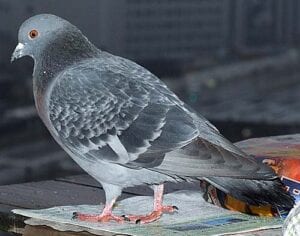
The British Trust for Ornithology was more circumspect on the role of color in the drop zone for birds.
“We do know that birds can be attracted to certain colors during display but it [droppings on cars] is probably more to do with where you park; if you park where birds roost, then you are going to get more droppings on your vehicle,” a spokesman said.
If, or more likely when, you find bird poop on your car, here is a short guide on how to remove it to avoid damage.
1. Remove at the earliest opportunity
2. A moist cloth should be used to gently lift the deposit from the vehicle surface.
3. If the deposit is dry or doesn’t lift easily, place a moist cloth over it for ten minutes to soften the deposit
4. Dispose of any cloth or wipe used to remove bird droppings immediately and carefully wash your hands, as bird lime can harbor diseases
Source
Pigeon Patrol Products & Services is the leading manufacturer and distributor of bird deterrent (control) products in Canada. Pigeon Patrol products have solved pest bird problems in industrial, commercial, and residential settings since 2000, by using safe and humane bird deterrents with only bird and animal friendly solutions. At Pigeon Patrol, we manufacture and offer a variety of bird deterrents, ranging from Ultra-flex Bird Spikes with UV protection, Bird Netting, 4-S Bird Gel and the best Ultrasonic and audible sound devices on the market today.
Voted Best Canadian wholesaler for Bird Deterrent products ten years in a row.
Contact us at 1- 877– 4– NO-BIRD, (604) 585-9279 or visit our website at www.pigeonpatrol.ca
Pigeon/Pigeon Patrol / Pigeons Roosting / Vancouver Pigeon Control /Bird Spikes / Bird Control / Bird Deterrent / Pigeon Deterrent? Surrey Pigeon Control / Pest /Seagull deterrent / Vancouver Pigeon Blog / Birds Inside Home / Pigeons in the cities / Ice Pigeons/ What to do about pigeons/ sparrows , Damage by Sparrows, How To Keep Raccoons Away, Why Are Raccoons Considered Pests/ De-fence / Pigeon Nesting/ Bird Droppings / Pigeon Dropping/ woodpecker control/ Professional Bird Control Company/ Keep The Birds Away/ Birds/rats/ seagull/pigeon/woodpecker/ dove/sparrow/pidgeon control/pidgeon problem/ pidgeon control/flying rats/ pigeon Problems/ bird netting/bird gel/bird spray/bird nails/ bird guard
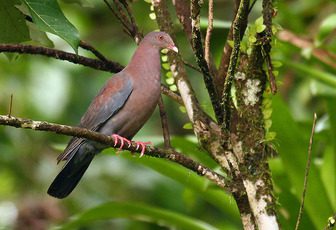
by Pigeon Patrol | Aug 17, 2021 | Bird Deterrent Products, Bird Law, Bird Netting, Bird Spikes, Columbidae, Doves
The Red-billed Pigeon, Patagioenas flavirostris , is a relatively large pigeon which breeds from southern Texas, United States, and northwestern Mexico south to Costa Rica. It belongs to a clade of Patagioenas which generally lack iridescent display plumage, except some vestiges in the Pale-vented Pigeon.
The Red-billed pigeon is classified as Least Concern. Does not qualify for a more at risk category. Widespread and abundant taxa are included in this category.
The Red-billed Pigeon, Patagioenas flavirostris (see Johnson et al. 2001), is a relatively large pigeon which breeds from southern Texas, United States, and northwestern Mexico south to Costa Rica. It belongs to a clade of Patagioenas which generally lack iridescent display plumage, except some vestiges in the Pale-vented Pigeon. It is found in open country with some trees, large clearings and cultivation in lowlands and middle altitudes to 2100 meters.
The Red-billed Pigeon has a large range, estimated globally at 830,000 square kilometers. Native to the United States and Mexico as well as Belize, Costa Rica, El Salvador, Guatemala, Honduras, and Nicaragua, this bird prefers neritic, oceanic, and coastal marine ecosystems. The global population of this bird is estimated at 500,000 to 5,000,000 individuals and does not show signs of decline that would necessitate inclusion on the IUCN Red List.
Red-billed Pigeons in a palm tree in Alajuela, Costa Rica. We first heard their “Cooc cu cu coooo!” calls coming from the palm tree and then easily spotted these large, conspicuous pigeons. Red-billed Pigeon (Patagioenas flavirostris) Adult Red-billed Pigeons have a dull, reddish purple head, breast, and shoulders, a slate gray belly, rump, tail, and wings, magenta legs, orange eyes with a red eye-ring, and a distinctive yellowish white bill with a pinkish red base and cere.
Red-billed Pigeon: Breeds from south Sonora, Mexico south in lowlands along the Pacific slope to Chiapas, and the lower Rio Grande Valley of south Texas and Mexico from eastern Nuevo Leon and Tamaulipas, south along the Atlantic slope to the Yucatan states. Populations of northeastern Mexico and Texas move south during non-breeding season. Preferred habitat includes tropical deciduous forests.
Source
Pigeon Patrol Products & Services is the leading manufacturer and distributor of bird deterrent (control) products in Canada. Pigeon Patrol products have solved pest bird problems in industrial, commercial, and residential settings since 2000, by using safe and humane bird deterrents with only bird and animal friendly solutions. At Pigeon Patrol, we manufacture and offer a variety of bird deterrents, ranging from Ultra-flex Bird Spikes with UV protection, Bird Netting, 4-S Bird Gel and the best Ultrasonic and audible sound devices on the market today.
Voted Best Canadian wholesaler for Bird Deterrent products ten years in a row.
Contact us at 1- 877– 4– NO-BIRD, (604) 585-9279 or visit our website at www.pigeonpatrol.ca
Pigeon/Pigeon Patrol / Pigeons Roosting / Vancouver Pigeon Control /Bird Spikes / Bird Control / Bird Deterrent / Pigeon Deterrent? Surrey Pigeon Control / Pest /Seagull deterrent / Vancouver Pigeon Blog / Birds Inside Home / Pigeons in the cities / Ice Pigeons/ What to do about pigeons/ sparrows , Damage by Sparrows, How To Keep Raccoons Away, Why Are Raccoons Considered Pests/ De-fence / Pigeon Nesting/ Bird Droppings / Pigeon Dropping/ woodpecker control/ Professional Bird Control Company/ Keep The Birds Away/ Birds/rats/ seagull/pigeon/woodpecker/ dove/sparrow/pidgeon control/pidgeon problem/ pidgeon control/flying rats/ pigeon Problems/ bird netting/bird gel/bird spray/bird nails/ bird guard
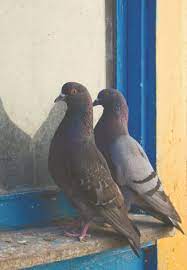
by Pigeon Patrol | Aug 9, 2021 | Bird Spikes, Columbidae, Doves, history of pigeons, MBCA, pet bird, Pigeon Control
DEAR JOAN: Yesterday afternoon I blew the leaves off the lawn and garden in my backyard, leaving a lot of bare soil showing. A couple of hours later, I happened to look outside and to my wondering eyes there appeared a dozen beautiful little robins, pecking away all over the yard.
I must have unearthed grubs or something edible, but how did they know that? They stayed an hour, then took off together. What a delight.
Earlier in the week I awoke at 3 a.m. to the smell of a skunk in my front yard. I live in a neighborhood of small houses, all with the fenced yards. I never cease to wonder how these wild creatures manage to get around and find food.

Dorothy Rich
Bay Area
DEAR DOROTHY: Birds have such supercharged metabolisms that when they are active, they pretty much have to eat constantly to maintain their energy. As a result, birds are exceptionally good at finding food.
They do this not by scent — with very few exceptions, birds have a rotten sense of smell — but by sight and sound.
As they fly and flit around, they are scoping out the landscape. They may spot a bird feeder, a bush full of berries, or a cleared patch of dirt. They may not recognize it as such, but they see the changes in the landscape and drop down to explore.
Birds have amazing little brains and memories, so the robins probably noticed something had changed in your yard, and that all that dirt was holding a feast.
Birds also listen to the calls and coos of other birds, which can tip them off about a source of food.
American robins eat a variety of foods, but they certainly love nice juicy worms, and they are most adept at finding them.
Folks used to believe the robins could hear the worms crawling about beneath the soil, but researchers have found that it’s just experience. They know where worms likely are, and they hunt them out, not unlike me and frozen yogurt shops.
As for the skunks and other critters, they too are driven by the need for food and water, and they are undeterred by urban fences.
Mating season for skunks usually begins in February, but I’m already seeing a lot of skunks out and about, and unfortunately, dead on the roads, so I think they might be getting an early start this year. Just a reminder that the males use their scent to attract females, so we will be smelling that pungent aroma a lot in the coming weeks.
Hero Dog awards
The American Humane Association, a national organization that works to improve the lives of both animals and children, has launched its annual Hero Dog awards to recognize the country’s bravest heroes on both ends of the leash.
The awards are divided into eight categories — therapy, service, law enforcement, military, arson, search and rescue, guide/hearing and “emerging hero” dogs, which pays tribute to ordinary dogs that do extraordinary things.
Winners in each category will be treated to a Los Angeles gala awards ceremony in September, where one of the finalists will be named top dog.
Source
Pigeon Patrol Products & Services is the leading manufacturer and distributor of bird deterrent (control) products in Canada. Pigeon Patrol products have solved pest bird problems in industrial, commercial, and residential settings since 2000, by using safe and humane bird deterrents with only bird and animal friendly solutions. At Pigeon Patrol, we manufacture and offer a variety of bird deterrents, ranging from Ultra-flex Bird Spikes with UV protection, Bird Netting, 4-S Bird Gel and the best Ultrasonic and audible sound devices on the market today.
Voted Best Canadian wholesaler for Bird Deterrent products ten years in a row.
Contact us at 1- 877– 4– NO-BIRD, (604) 585-9279 or visit our website at www.pigeonpatrol.ca
Pigeon/Pigeon Patrol / Pigeons Roosting / Vancouver Pigeon Control /Bird Spikes / Bird Control / Bird Deterrent / Pigeon Deterrent? Surrey Pigeon Control / Pest /Seagull deterrent / Vancouver Pigeon Blog / Birds Inside Home / Pigeons in the cities / Ice Pigeons/ What to do about pigeons/ sparrows , Damage by Sparrows, How To Keep Raccoons Away, Why Are Raccoons Considered Pests/ De-fence / Pigeon Nesting/ Bird Droppings / Pigeon Dropping/ woodpecker control/ Professional Bird Control Company/ Keep The Birds Away/ Birds/rats/ seagull/pigeon/woodpecker/ dove/sparrow/pidgeon control/pidgeon problem/ pidgeon control/flying rats/ pigeon Problems/ bird netting/bird gel/bird spray/bird nails/ bird guard
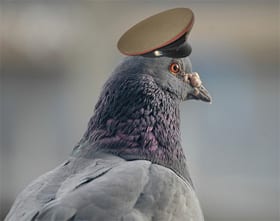
by Pigeon Patrol | Aug 3, 2021 | Bird Law, Bird Netting, Bird Spikes, Columbidae, Doves, history of pigeons, MBCA
In the third floor hallway of the Pentagon, just outside the Army Chief of Staff’s office, there is a pigeon.
Walking the corridors, the lifelike pigeon stands out among the cases of military history that display Revolutionary-era bayonets, Civil War uniforms and replicas of helicopters used in Vietnam. Upon closer inspection, one might notice the pigeon is so life-like because it has been taxidermied. It’s also missing one leg.
That pigeon’s name is “President Wilson” — an unsung hero of World War I that made a daring flight to save U.S. troops exactly 100 years ago on Friday.
President Wilson was a military carrier pigeon, one of many in the U.S. Army Signal Corps that delivered messages between commanders and troops on the front lines. The pigeons were especially useful tools of communication during World War I when the telephone and telegraph were still unreliable new technologies.
According to U.S. military accounts recorded in the U.S. Army Center of Military History and the National Archives, Wilson was born in France and first assigned to the U.S. Army’s newly formed Tank Corps, delivering messages to Tank Battalions commanded by Col. George S. Patton in the Battle of Saint-Mihiel.
But soon afterward, Wilson was assigned to an infantry unit conducting operations near Grandpré during the Meuse-Argonne Offensive.
On the morning of Oct. 5, 1918, his unit came under attack, and Wilson was dispatched to send a message that the unit needed artillery support. During the 25-mile journey, German soldiers spotted him and began firing into his flight path. (It should be noted that some accounts of Wilson’s heroics place the event as occurring on Nov. 5, but multiple historians reached by ABC corroborated the Oct. 5 date.)
Wilson was hit several times, losing a leg and suffering a wound to his chest, but he managed to deliver the message in a record 25 minutes.
Surviving his wounds, Wilson was retired and sent to the U.S. Army Signal Corps Breeding and Training Center at Fort Monmouth, New Jersey, where he would live another eleven years.
After his death, Wilson was taxidermied and presented to the Smithsonian Institution before being transferred to the custody of the U.S. Army in 2008. Now, located in the prestigious halls of the U.S. military’s headquarters in Arlington, Virginia, Wilson serves as a reminder that these simple birds — often considered a nuisance by the general public — were once war heroes.
Carrier pigeons were used by both the Allied and Central Powers during World War I and could even provide updates to military commanders when launched in midair from planes.
“Launched mid-mission, the birds would fly back to their coops and update ground commanders on what the pilots had observed,” the National Archives wrote in a blog post in January. “Quick updates like this were essential for leaders to know what the battlefield looked like and what the enemy was doing in its own trenches.”
“Tanks carried the birds in order to relay the advance of individual units. Even after the introduction of the radio, pigeons were often the easiest way to help coordinate tank units without exposing the men to dangerous fire. Without a radio set, the soldiers would have had to leave the relative safety of their tanks to relay or receive orders,” the Archives said.
When the pigeons weren’t in use, they were stored in mobile units, often converted horse carriages or even double-decker buses.
The birds are thought to use low-frequency sound waves to map their environments and find their way from location to location.
Another famous World War I pigeon was known as Cher Ami — his moment of heroism came during the Meuse-Argonne Offensive in the fall of 1918.
The German Army surrounded elements of the 77th Division for five days, at one moment confusing the Americans as they accidentally shelled their own men in an attempt to fire at the enemy.
Messages were unable to get to U.S. commanders, so Cher Ami was released as the division’s last hope. Like Wilson, Cher Ami flew through a barrage of gunfire, also sustaining injuries to his leg and chest. But he successfully delivered the message, ending the friendly fire.
The French even awarded Cher Ami the Croix de Guerre with Palm, a military decoration, for his service.
Military carrier pigeons were again used in World War II. In that war, 32 pigeons were awarded the United Kingdom’s Dickin Medal for their heroic actions.
Source
Pigeon Patrol Products & Services is the leading manufacturer and distributor of bird deterrent (control) products in Canada. Pigeon Patrol products have solved pest bird problems in industrial, commercial, and residential settings since 2000, by using safe and humane bird deterrents with only bird and animal friendly solutions. At Pigeon Patrol, we manufacture and offer a variety of bird deterrents, ranging from Ultra-flex Bird Spikes with UV protection, Bird Netting, 4-S Bird Gel and the best Ultrasonic and audible sound devices on the market today.
Voted Best Canadian wholesaler for Bird Deterrent products ten years in a row.
Contact us at 1- 877– 4– NO-BIRD, (604) 585-9279 or visit our website at www.pigeonpatrol.ca
Pigeon/Pigeon Patrol / Pigeons Roosting / Vancouver Pigeon Control /Bird Spikes / Bird Control / Bird Deterrent / Pigeon Deterrent? Surrey Pigeon Control / Pest /Seagull deterrent / Vancouver Pigeon Blog / Birds Inside Home / Pigeons in the cities / Ice Pigeons/ What to do about pigeons/ sparrows , Damage by Sparrows, How To Keep Raccoons Away, Why Are Raccoons Considered Pests/ De-fence / Pigeon Nesting/ Bird Droppings / Pigeon Dropping/ woodpecker control/ Professional Bird Control Company/ Keep The Birds Away/ Birds/rats/ seagull/pigeon/woodpecker/ dove/sparrow/pidgeon control/pidgeon problem/ pidgeon control/flying rats/ pigeon Problems/ bird netting/bird gel/bird spray/bird nails/ bird guard
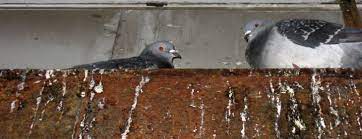
by Pigeon Patrol | Aug 3, 2021 | Bird Deterrent Products, Bird Law, Bird Netting, Bird Spikes, Columbidae, Doves
The feral pigeon (Columba livia) carries with it a reputation that runs counter to conservation: it is feral, exotic and invasive and even considered down right filthy. But upon closer inspection, the pigeon could be a subject worthy of study for both ecological and social science purposes and highlight the importance of urban species in ecology. This insight on pigeons occurred during an urban ecology study that focused on habitat and population dynamics of the birds and is also supported through an extensive literature review. As a nearly ubiquitous species, we discuss how important pigeons are as a prey-base for numerous raptors and underscore our position by highlighting several studies on the biological uptake of environmental contaminants that may have benefited from including the pigeon as part of the research. We further our stance on the importance of pigeons in urban ecology by highlighting additional concerns such as zoonotic disease and climate change. We expand our case by turning to the social construction of nature, the importance of public participation in conservation. Once again, the ubiquitous presence of pigeons lends itself well to citizen science in ecology and conservation, especially to show trends across a range of geographic locations. In short, this commentary strives to reconceptualize the feral pigeon, promoting the bird as a valuable asset to ecological and social research in ways that raise awareness for conservation concerns and advance our scientific thinking.
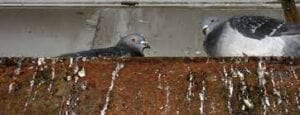
Source
Pigeon Patrol Products & Services is the leading manufacturer and distributor of bird deterrent (control) products in Canada. Pigeon Patrol products have solved pest bird problems in industrial, commercial, and residential settings since 2000, by using safe and humane bird deterrents with only bird and animal friendly solutions. At Pigeon Patrol, we manufacture and offer a variety of bird deterrents, ranging from Ultra-flex Bird Spikes with UV protection, Bird Netting, 4-S Bird Gel and the best Ultrasonic and audible sound devices on the market today.
Voted Best Canadian wholesaler for Bird Deterrent products ten years in a row.
Contact us at 1- 877– 4– NO-BIRD, (604) 585-9279 or visit our website at www.pigeonpatrol.ca
Pigeon/Pigeon Patrol / Pigeons Roosting / Vancouver Pigeon Control /Bird Spikes / Bird Control / Bird Deterrent / Pigeon Deterrent? Surrey Pigeon Control / Pest /Seagull deterrent / Vancouver Pigeon Blog / Birds Inside Home / Pigeons in the cities / Ice Pigeons/ What to do about pigeons/ sparrows , Damage by Sparrows, How To Keep Raccoons Away, Why Are Raccoons Considered Pests/ De-fence / Pigeon Nesting/ Bird Droppings / Pigeon Dropping/ woodpecker control/ Professional Bird Control Company/ Keep The Birds Away/ Birds/rats/ seagull/pigeon/woodpecker/ dove/sparrow/pidgeon control/pidgeon problem/ pidgeon control/flying rats/ pigeon Problems/ bird netting/bird gel/bird spray/bird nails/ bird guard
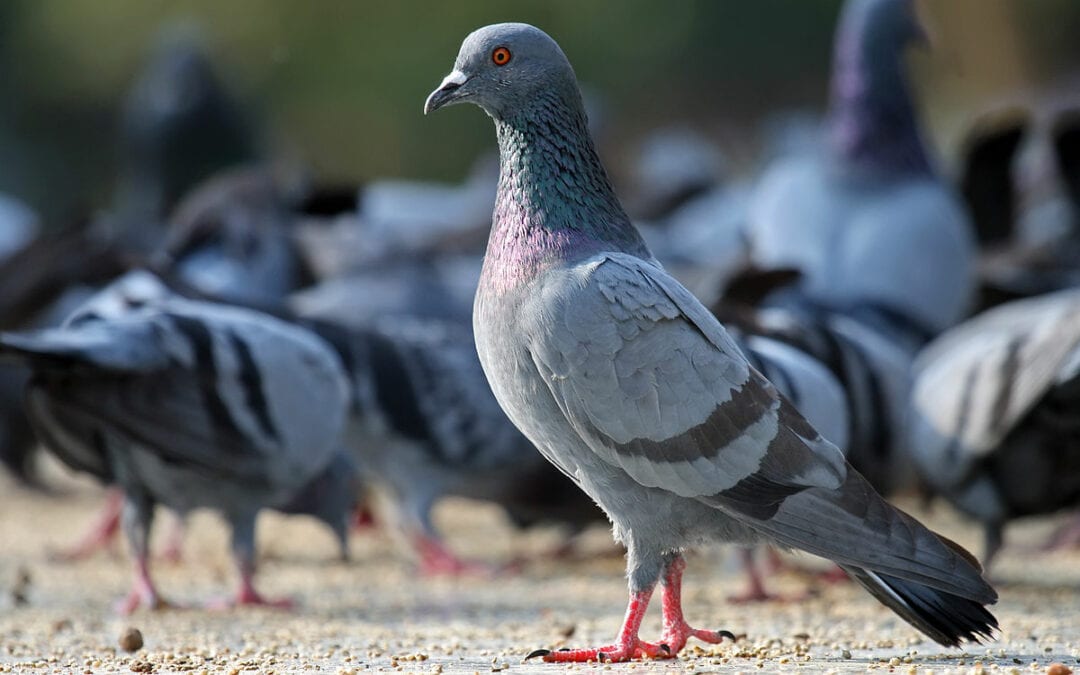
by Pigeon Patrol | Jul 27, 2021 | Bird Netting, Columbidae, Doves, Pigeons in the News, Raccoons, Sparrows
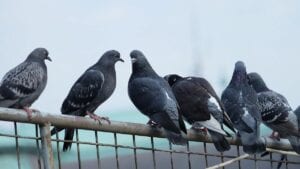
Pigeon shoots are examples of “contested traditions” that invite comparison with other controversial spectacles of killing animals, such as cockfights and dogfights. In the United States during the late twentieth century, mass protests of America’s largest public pigeon shoot occurred in Hegins, Pennsylvania. This article offers a folkloristic perspective on the contested tradition by analyzing how the protest rhetorically served to present tradition as a “problem” in the ethical modernization of society. The clash between animal rights protestors and supporters of the shoot became a moral drama based on a clash of rural and cosmopolitan values in modern America that derives from fundamentally different views of human dominion over the land and its creatures. The interpretation of the event hinges on a semiotic layering that takes into ethnographic consideration the different meanings of symbols for various participants in the event. Compromise became impossible in controversies over pigeon shoots because the sides perceived symbols so differently. For protestors, the shooters represented predatory, phallocentric rapists who promoted violence for its own sake, whereas, for supporters, they symbolized a pioneer and biblical heritage based on human dominion over the bountiful land. For protestors, the process of the ritualized shoot perpetuated cycles of abuse and patriarchy; for protestors, it acted to regenerate the land, confirming the wholesomeness of agrarianism. The pigeons could be symbolized as profane, dirty pests or sacred doves of peace. The widely publicized controversy implied larger questions, and fundamental conflicts in America, about the role of tradition in modernity.
Source
Pigeon Patrol Products & Services is the leading manufacturer and distributor of bird deterrent (control) products in Canada. Pigeon Patrol products have solved pest bird problems in industrial, commercial, and residential settings since 2000, by using safe and humane bird deterrents with only bird and animal friendly solutions. At Pigeon Patrol, we manufacture and offer a variety of bird deterrents, ranging from Ultra-flex Bird Spikes with UV protection, Bird Netting, 4-S Bird Gel and the best Ultrasonic and audible sound devices on the market today.
Voted Best Canadian wholesaler for Bird Deterrent products ten years in a row.
Contact us at 1- 877– 4– NO-BIRD, (604) 585-9279 or visit our website at www.pigeonpatrol.ca
Pigeon/Pigeon Patrol / Pigeons Roosting / Vancouver Pigeon Control /Bird Spikes / Bird Control / Bird Deterrent / Pigeon Deterrent? Surrey Pigeon Control / Pest /Seagull deterrent / Vancouver Pigeon Blog / Birds Inside Home / Pigeons in the cities / Ice Pigeons/ What to do about pigeons/ sparrows , Damage by Sparrows, How To Keep Raccoons Away, Why Are Raccoons Considered Pests/ De-fence / Pigeon Nesting/ Bird Droppings / Pigeon Dropping/ woodpecker control/ Professional Bird Control Company/ Keep The Birds Away/ Birds/rats/ seagull/pigeon/woodpecker/ dove/sparrow/pidgeon control/pidgeon problem/ pidgeon control/flying rats/ pigeon Problems/ bird netting/bird gel/bird spray/bird nails/ bird guard










